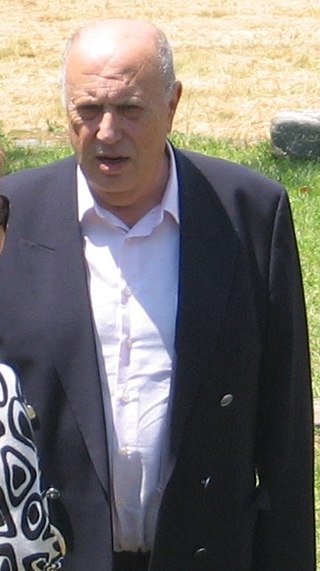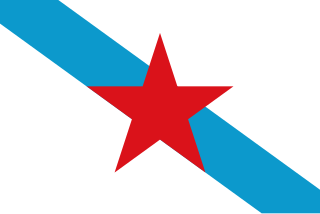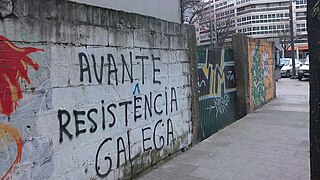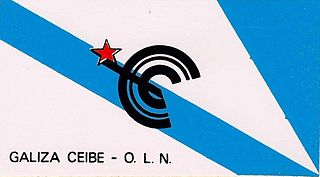Related Research Articles

The Galician Nationalist Bloc is a political party from Galicia, formed with the merger of a series of left-wing Galician nationalist parties. It is self-defined as a "patriotic front".

Ricardo Carballo Calero, self-styled as Ricardo Carvalho Calero from 1981 onward, was a Spanish philologist, academic and writer. He was the first Professor of Galician Language and Literature at the University of Santiago de Compostela. He was a member of the Royal Galician Academy, the Lisbon Academy of Sciences, and also an honorary member of the Galician Language Association. He was one of the main theorists of contemporary Galician reintegrationism and his works on this field are considered a primary reference. Many consider Carballo Calero as one of the most prominent figures of the twentieth century Galician intelligentsia.

Xosé Luís Méndez Ferrín is a Galician writer and poet and is widely considered the highest representative of contemporary Galician literature. A doctor in philology, he studied philosophy at the University of Santiago de Compostela and Romanic philology at the University of Madrid.
The Galician People's Union is a Galician nationalist and communist political party, and is one of the registered political parties of Spain. The party publishes the magazine Terra e Tempo, and the secretary general is Néstor Rego.
The Galician People's Front is a Galician political organization with a socialist and independentist ideology.

Galician nationalism is a form of nationalism found mostly in Galicia, which asserts that Galicians are a nation and that promotes the cultural unity of Galicians. The political movement referred to as modern Galician nationalism was born at the beginning of the twentieth century from the idea of Galicianism.

Xosé Manuel Hixinio Beiras Torrado is a Galician politician, economist, writer and intellectual. He is professor of Structural Economy at the Faculty of Economic Sciences of the University of Santiago de Compostela. He is a former member of the National Council of the Galician Nationalist Bloc, he is currently the leader of Renewal–Nationalist Brotherhood, an independentist political party. He formerly had representation in the Galician parliament.

Resistência Galega, sometimes referred to as REGA, is the term used by a series of left-wing and Galician separatist organisations and individuals to claim attacks in Galicia. The term was first used in 2005 when a manifesto named Manifesto da Resistência Galega appeared on the Internet. Since then, Resistência Galega has carried out dozens of attacks against political party offices and banks across Galicia.

Galiza Ceibe-OLN was an independentist and socialist political party in Galicia, Spain. Galiza Ceibe was founded on 1980 by the Galician Party of the Proletariat as a political and electoral front, originally to present a list in Vigo and in other galician municipalities under the name Agrupación Electoral Galicia Ceibe in the 1979 local elections.
The Assembly of the United People (APU) was a Galician political organization, with an independentist, socialist and feminist ideology. It was formed in 1989 from a split of the first Galician People's Front, and disappeared with its self-dissolution in 1995.
The Galician Party of the Proletariat (PGP) was a party galician independentist and Marxist-Leninist party formed in March 1978, as a continuation of Galician People's Union-Proletarian Line, a split of the original Galician People's Union. The Central Committee was clandestine, and even the party militants didn't know the members of it. The party supported armed struggle, which considered as anti-imperialist and anti-oligarchic. Its official magazine was called Sempre en Galiza.
Isca! is the name of a Galician youth organization that promotes Galician independence, combined with anti-capitalist and feminist ideology. They are linked to the Galician Movement for Socialism, a socialist and pro-independence party that forms part of the Galician Nationalist Bloc (BNG).

The Galician Socialist Party was a socialist and Galician nationalist political party active in Galicia.
The Federación de Mocedades Galeguistas was the youth organization of the Partido Galeguista, which was formed in January 1934, bringing together the different local nationalist youth organizations that had been formed since 1932. It had around 1,000 members, its official organ was the Guieiro, and their leaders were Xaime Illa Couto, Celso Emilio Ferreiro, Xosé Velo and Ramón Piñeiro López.

The Galician independence movement or the Galician separatist movement is a political movement which supports the independence of Galicia and the other Galician-speaking territories outside the Autonomous Community of Galicia, including As Portelas, O Bierzo, and the Eo-Navian lands from Spain.
The Galician Armed League was an armed organization formed by former members of the GRAPO. They injured two policemen in 1978, and claimed to have killed a Guardia Civil the same year in Santiago de Compostela, though the GRAPO also claimed the murder. The group was completed disbanded in 1980.

Sindicato Labrego Galego-Comisións Labregas is a Galician farmers' and breeders' union centered on family farms and small peasants.
The Exército Guerrilheiro do Povo Galego Ceive was an armed organization formed in 1986 mainly by members of Galiza Ceibe-OLN. It was considered a terrorist organisation by the Spanish Government. The main goals of the organization were the independence of Galicia and the transformation of society according to the principles of socialism. The EGPGC was operative between 1987 and 1991, a time during which the EGPGC made a total of 90 armed actions and a multitude of provisioning actions.

Manuel María Fernández Teixeiro, better known as Manuel María, was a Spanish poet and academic who wrote in the Galician language. He was notable for his combative character and his political commitment. His poetry touched on themes of love, art, his own political commitment, drawing attention to wrongs, ethnography, physics, history, immateriality, mythology, the animal world, poetic expression, the passing of time, religion, society, language, agricultural labour, urbanism, and geography. The Day of Galician Literature was devoted to him in 2016.

Galicia irredenta or Galicia estremeira, also spelled as Galiza irredenta and Galiza estremeira and also known as Faixa Leste or Franxa Leste, is a term used for all Galician-speaking territories located outside of Galicia. These are all located in Spain, in either Asturias or Castile and León. These territories are sometimes divided into three subregions: El Bierzo, Eo-Navia and As Portelas.
References
- ↑ Xosé Manuel del Caño (2005): Conversas con Méndez Ferrín. Historia, literatura, nación. Edicións Xerais, Vigo.
- ↑ Nieto Pereira, Xosé Cid Cabido, Antom Árias Curto, Edelmiro Domingues, Francisco Atanes and Arturo Estévez.
- Various Authors.A Gran Historia de Galicia XVI: a Galicia autónoma (dende a Transición). Volume 1: A Transición en Galicia, Arrecife Edicións Galegas/La Voz de Galicia, 2007, A Coruña.
- Justo Beramendi and Núñez Seixas, O Nacionalismo Galego, Edicións A Nosa Terra, Vigo, 1995. Page 280.
- Rios Bergantinhos, Noa. A esquerda independentista galega (1977-1995). Abrente Editora, Santiago de Compostela, 2002.